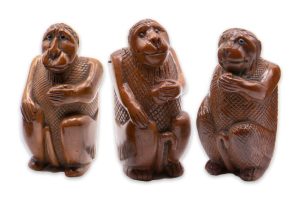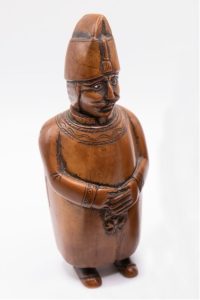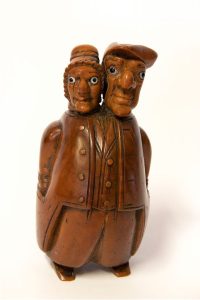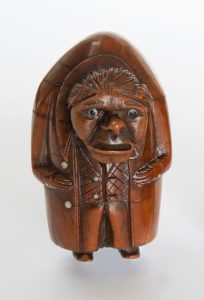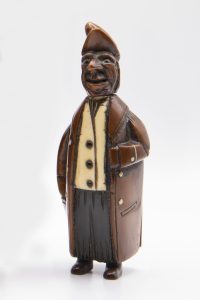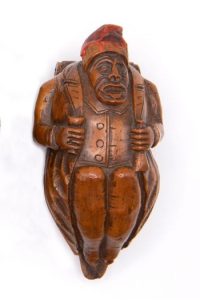Gallery
Click on a photo to enlarge
All
- All
- Religion and Religious Portraits
- Zoomorphic, Anthropomorphic, and Therianthropic Imagery
- Liberty and Anti-Slavery Representations
- Portraits and Caricatures
- Military and War Imagery
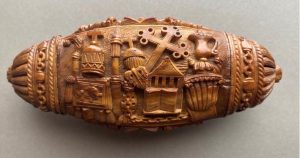
A double-sided coquilla nut snuff box made from three nuts, ca. 1805. The intricate carving on this large box depicts ritual objects (such as a cross and a globus cruciger, an orb topped by a cross, representative of Jesus’ worldly kingdom) suggestive of Catholic, and more specifically Jesuit, associations broadly. Length: 12 cm (4.7 in.).
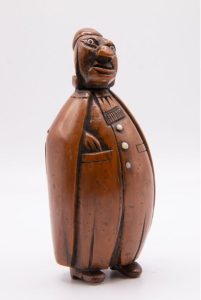
Coquilla nut snuff box depicting a Sephardic Jewish rabbi, ca. 1790. The subject is identified by wearing preaching bands, a tallit, and a kippa; the whalebone buttons are indicative of a sailors’ work, possibly completed on the owner’s whaling ship as either a commission or for presentation. Height: 10.8 cm (4.3 in.).
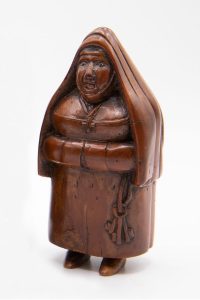
A figural coquilla nut snuff boxes likely depicting Sister Joana Angélica de Jesus, ca. 1820s. A Brazilian nun of the Reformed Order of Our Lady of Conception, she was an important martyr of the Brazilian War of Independence. In the left-hand image, she is identified by the set of keys to the Convent attached to the girdle at her waist, keys she refused to hand over to the attacking soldiers. The keys are symbolic of her protection of the convent at the door of which she was bayoneted by the Portuguese. Height: left 7.7 cm (3 in.).
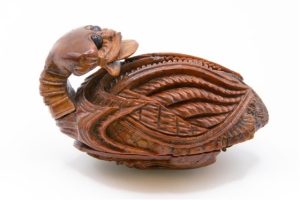
Coquilla nut snuff box in the form of sankofa, ca. 1865. The form of a bird with an elongated neck facing away from the direction of its body is one of the most famous and potent adinkra from the Asante Kingdom and Akan peoples broadly. It refers to the importance of knowing where one has gone before one can go forward, thus acting as a potent metaphor for, and reflection on, the history of the African diaspora. The symbol is widely reproduced and discussed in contemporary art and scholarship. Length: 7.6 cm (3 in.).
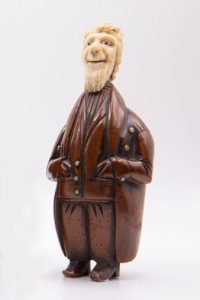
A coquilla nut snuff box depicting John Brown, ca. 1860. Brown’s death was mourned and commemorated in the United States and Haiti, among other locales. This box may be evidence of that event as well as its maker’s opinions on abolitionism. Brown’s face – made of whale ivory – not only emphasizes his racial identity but adds a prestige element to the box. Height: 10.7 cm (4.2 in.).
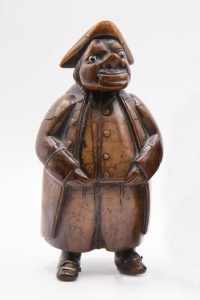
A figural coquilla nut snuff box, ca. 1800. With facial features that could be either satirical or intended as a portrait, this box is representative of the diverse range of styles seen on figural snuff boxes in the Badger Collection. Here the subject is shown wearing a tricorne hat and a coat; silver buckles have been added to his shoes. Height: 10.2 cm (4 in).
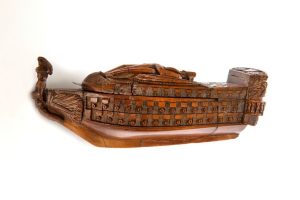
Coquilla nut snuff box in the form of the French ship, Scipion, ca. 1804. Scipion was a Téméraire-class, two-deck ship. This second-phase box is defined by the second nut added in the construction to elongate the deck from the stern. It depicts Napoleon on the lid, the Roman general Scipio Africanus – the ship’s namesake – as the prow figure. The name of the ship is carved on the stern. This was a accurate representation of the French warship which was later captured by the British. Length: 12 cm (4.8 in.).
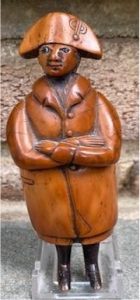
Coquilla nut snuff box depicting Napoleon, early nineteenth century. This is likely the earliest known representation of Napoleon in a snuff box. His greatcoat and riding boots suggest a more accurate approach to his portrayal in uniform, as he wore a fur-lined greatcoat when he crossed the Alps in May 1800. This box’s original coquilla hinge was damaged in the past and later replaced in brass. Height: 11.6 cm (4.6 in.).
